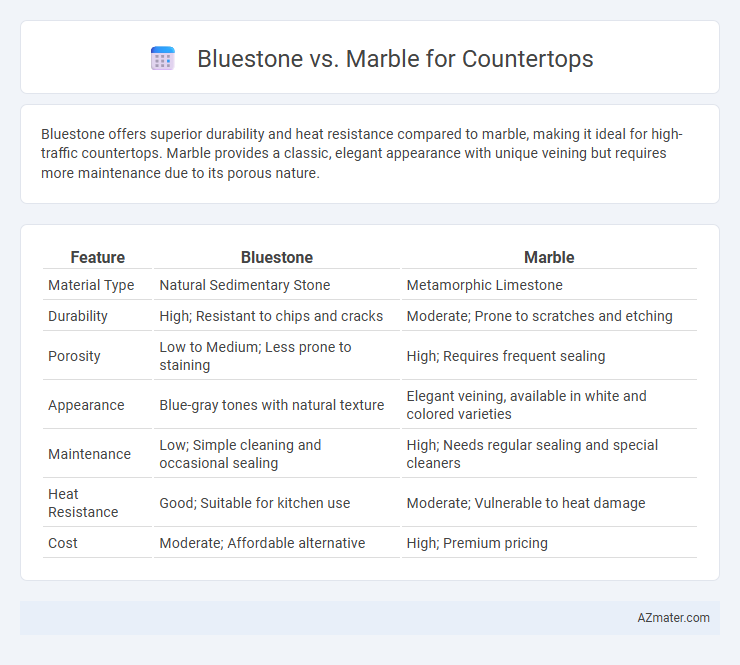Bluestone offers superior durability and heat resistance compared to marble, making it ideal for high-traffic countertops. Marble provides a classic, elegant appearance with unique veining but requires more maintenance due to its porous nature.
Table of Comparison
| Feature | Bluestone | Marble |
|---|---|---|
| Material Type | Natural Sedimentary Stone | Metamorphic Limestone |
| Durability | High; Resistant to chips and cracks | Moderate; Prone to scratches and etching |
| Porosity | Low to Medium; Less prone to staining | High; Requires frequent sealing |
| Appearance | Blue-gray tones with natural texture | Elegant veining, available in white and colored varieties |
| Maintenance | Low; Simple cleaning and occasional sealing | High; Needs regular sealing and special cleaners |
| Heat Resistance | Good; Suitable for kitchen use | Moderate; Vulnerable to heat damage |
| Cost | Moderate; Affordable alternative | High; Premium pricing |
Introduction to Bluestone and Marble Countertops
Bluestone countertops are crafted from dense, durable sandstone known for its rich blue-gray hues and natural slip resistance, making it ideal for both indoor and outdoor kitchen applications. Marble countertops, composed of metamorphic limestone, showcase elegant veining patterns and a smooth, polished surface favored for luxury kitchen designs but require regular sealing to prevent staining. Both materials offer distinct aesthetic and functional qualities, with bluestone excelling in durability and slip resistance, while marble is prized for its timeless beauty and classic appeal.
Key Differences Between Bluestone and Marble
Bluestone is a dense, durable natural stone with a matte finish and excellent resistance to scratches and heat, making it ideal for kitchen countertops. Marble, composed mainly of calcite, features a polished surface with distinctive veining, offering a luxurious aesthetic but requires more maintenance due to its susceptibility to staining and etching. Bluestone's uniform texture contrasts with marble's unique veining patterns, influencing both style and durability in countertop applications.
Appearance and Aesthetic Appeal
Bluestone countertops exhibit a rich, deep blue to gray color palette with a unique, natural cleft texture that enhances rustic and contemporary kitchen designs. Marble countertops, on the other hand, are prized for their luxurious veining patterns in shades of white, black, green, or pink, providing a classic, elegant aesthetic. While bluestone offers a more rugged, matte finish, marble boasts a polished, glossy surface that adds brightness and sophistication to any space.
Durability and Longevity Comparison
Bluestone countertops offer exceptional durability due to their dense, fine-grained composition, resisting scratches and heat effectively, making them ideal for heavy-use kitchen environments. Marble, while prized for its aesthetic appeal, is more porous and softer, which increases susceptibility to etching, staining, and surface damage over time. In longevity comparison, bluestone's resilience contributes to a longer lifespan with minimal maintenance, whereas marble requires regular sealing and careful handling to preserve its appearance and structural integrity.
Maintenance and Cleaning Requirements
Bluestone countertops require minimal maintenance, needing only periodic sealing to prevent staining and occasional wiping with mild soap and water for cleaning. Marble countertops, being softer and more porous, demand more frequent sealing and careful cleaning with pH-neutral products to avoid etching and stains. Bluestone's durability makes it more resistant to scratches and acids, while marble typically requires more diligent care to maintain its polished appearance.
Cost Comparison: Bluestone vs Marble
Bluestone countertops generally cost between $40 to $70 per square foot, offering an affordable alternative to marble, which ranges from $50 to $150 per square foot depending on quality and origin. Bluestone's lower price point results from its abundant availability and easier quarrying process, while marble's cost reflects its luxury status, unique veining, and higher maintenance requirements. Choosing bluestone over marble can save homeowners up to 50% on initial material expenses without compromising durability.
Suitability for Kitchen vs Bathroom Countertops
Bluestone offers superior durability and resistance to heat and moisture, making it highly suitable for kitchen countertops where heavy use and spills are common. Marble, while elegant and visually appealing, is more porous and prone to staining, which makes it better suited for bathroom countertops with less exposure to food and liquids. Both stones provide distinct aesthetic qualities, but bluestone's toughness is ideal for the demanding environment of kitchen surfaces.
Stain and Scratch Resistance
Bluestone countertops exhibit superior stain resistance compared to marble due to their dense, non-porous surface that repels liquids and minimizes discoloration. Marble, being a softer natural stone with higher porosity, is more susceptible to staining from acidic substances like wine or lemon juice without proper sealing. Bluestone also offers enhanced scratch resistance, making it a durable choice for high-traffic kitchen areas, whereas marble requires more careful handling to avoid surface damage.
Environmental Impact and Sustainability
Bluestone countertops are more environmentally sustainable than marble due to their lower extraction impact and higher durability, which reduces the need for frequent replacement. Marble quarrying generates significant waste and consumes more energy, contributing to greater carbon emissions compared to bluestone. Choosing bluestone supports eco-friendly construction by minimizing environmental disruption and promoting longevity in countertop materials.
Final Verdict: Choosing the Right Countertop Material
Bluestone offers exceptional durability, natural slip resistance, and a unique textured appearance, making it ideal for kitchens with high traffic and moisture exposure. Marble provides classic elegance and heat resistance but requires regular sealing and careful maintenance to prevent staining and etching. Choosing the right countertop material depends on balancing Bluestone's rugged practicality with Marble's timeless aesthetic and maintenance needs.

Infographic: Bluestone vs Marble for Countertop
 azmater.com
azmater.com